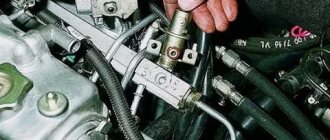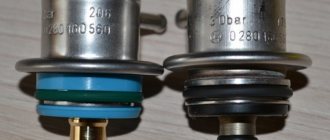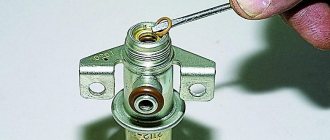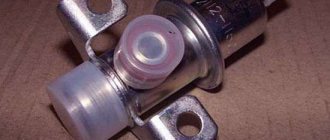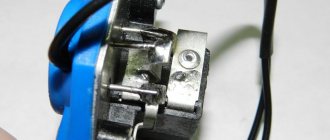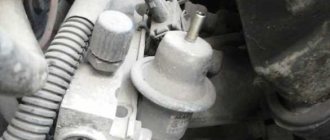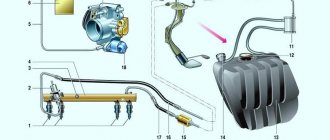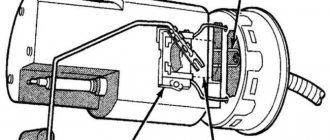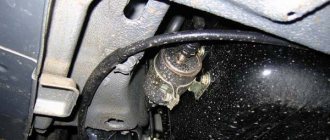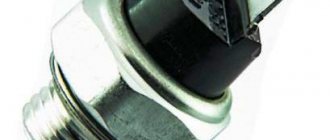Fuel pressure regulator malfunctions lead to the fact that the engine starts with difficulty, has “floating” idle speed, the car loses dynamic characteristics, and sometimes fuel leaks from the fuel hoses. As a rule, a fuel pressure regulator (abbreviated as RTD) is installed on the fuel rail and is a vacuum valve. In some car models, the RTD cuts into the fuel return hose of the fuel system. To determine that the fuel system malfunction lies in a faulty pressure regulator, it is necessary to carry out a series of simple checks.
Where is the fuel pressure regulator located?
To find the installation location of the fuel pressure regulator, let’s figure out what it is and what it is needed for. This will help in further searches and diagnostics.
The first thing you need to know is that there are two main types of RDTs - mechanical (old type) and electrical (new type). In the first case, this is a vacuum valve, the task of which is to transfer excess fuel under excessive pressure back into the fuel tank through the corresponding hose. In the second, it is a fuel pressure sensor that transmits relevant information to the ECU.
Typically, the fuel pressure regulator is located directly on the fuel rail. Another option for its placement is the fuel return hose of the power system. Another option is to locate the regulator directly in the fuel tank on the pump module. In such systems there is no fuel return hose as unnecessary. Such an implementation has several advantages, including simplified design (no extra pipeline), excess fuel does not enter the engine compartment, fuel heats up less and does not evaporate as much.
How does the fuel pressure regulator work?
Structurally, the old-style valve (installed on gasoline cars) has its own body, inside which there is a valve, a membrane and a spring. The housing has three fuel outlets. Through two of them, gasoline passes through the pressure regulator, and the third outlet is directly connected to the intake manifold. At low (including idle) engine speeds, the fuel pressure in the system is low and it all goes into the engine. As the speed increases, the corresponding pressure increases in the manifold, that is, at the third terminal of the RTD, a vacuum (vacuum) is created, which, at a certain value, overcomes the resistance force of its spring. This creates the movement of the membrane and the opening of the valve. Accordingly, excess fuel gains access to the second outlet of the regulator and goes back into the fuel tank through the return hose. Due to the described algorithm, the fuel pressure regulator is often called a check valve.
As for the fuel pressure sensor, it is a little more complicated. So, it consists of two parts - mechanical and electrical. The first part is a metal membrane that bends under the influence of force caused by pressure in the fuel system. The thickness of the membrane depends on the pressure for which the fuel system is designed. The electrical part of the sensor consists of four strain gauges connected according to a “Winston bridge” circuit. Voltage is applied to them, and the more the membrane bends, the greater the output voltage from them will be. And this signal is sent to the ECU. As a result, the electronic control unit sends the appropriate command to the pump so that it supplies only the amount of fuel required at the moment.
Diesel engines have a slightly different fuel pressure regulator design. In particular, they consist of a solenoid (coil) and a rod, which rests against the ball to shut off the reverse flow. This was done for the reason that the diesel engine vibrates very strongly during its operation, which affects the wear of the classic (gasoline) fuel regulator, that is, partial and even complete compensation of hydraulic vibrations occurs. However, its installation location is similar - in the engine fuel rail. Another option is on the fuel pump housing.
Design and operation of RTD
The RTD is a valve with a diaphragm that is installed in the fuel line. When the engine is running, a certain pressure is formed in the system, which must be maintained in the required range, but since the gas pump pumps fuel continuously, the pressure increases. When the pressure increases, the RTD opens the check valve and releases excess pressure into the return system, which communicates with the fuel tank.
Signs of a malfunctioning fuel pressure regulator
There are five main symptoms of a malfunctioning fuel pressure regulator (both types), which can be used to judge the complete or partial failure of this important unit. Moreover, the symptoms indicated below are typical for cars with both gasoline and diesel engines. However, it is worth mentioning that the listed situations may be signs of failure of other engine components (fuel pump, clogged fuel filter), so it is advisable to carry out comprehensive diagnostics in order to accurately determine its performance. So, the signs of a malfunctioning fuel pressure regulator are as follows:
- Difficulty starting the engine . This is usually expressed in a long rotation of the starter with the accelerator pedal depressed. Moreover, this sign is characteristic under any external weather conditions.
- The engine stalls at idle . To maintain its operation, the driver must constantly apply gas. Another option is that when the engine is idling, the speed is usually “floating”, unstable, until the engine stops completely.
- Loss of power and dynamics . Simply put, the car “does not pull,” especially when driving uphill and/or when loaded. The dynamic characteristics of the car are also lost, it accelerates poorly, that is, when trying to accelerate, a deep drop in revolutions occurs at their high values.
- Fuel is leaking from the fuel hoses (rail) . In this case, replacing hoses (clamps) and other nearby elements does not help.
- Excessive fuel consumption . Its value will depend on both the breakdown factors and the engine power.
Accordingly, if at least one of the above symptoms appears, it is necessary to perform additional diagnostics, including using an electronic error scanner available in the ECU memory.
Fuel pressure regulator error
Diagnostic errors of the fuel pressure regulator
In modern cars, a fuel pressure sensor is installed as a regulator. If it fails partially or completely, one or more errors associated with this unit are formed in the memory of the electronic engine control unit. At the same time, the engine malfunction light is activated on the dashboard.
When there is a DRT malfunction, the driver most often encounters errors numbered p2293 and p0089. The first is called “fuel pressure regulator - mechanical failure”. The second is “the fuel pressure regulator is faulty.” For some car owners, when the corresponding regulator fails, errors are formed in the ECU memory: p0087 “the pressure measured in the fuel rail is too low relative to the required one” or p0191 “fuel pressure regulator or pressure sensor.” The external signs of these errors are the same as the general signs of failure of the fuel pressure regulator.
, Scan Tool Pro Black Edition, will help you find out if there is such an error code in the ECU memory.
. This device is compatible with most all modern cars with an OBD-2 connector. It is enough to have a smartphone with an installed diagnostic application.
You can connect to the car control unit via Bluetooth or Wi-Fi. Scan Tool Pro, having a 32-bit chip and easy to connect to, reads and stores all sensor data not only in the engine, but also in the gearbox, transmission, or auxiliary systems ABS, ESP, etc. It can also be used to monitor fuel pressure readings in real time, which it transmits to the vehicle’s ECM while performing a series of checks.
Checking the fuel pressure regulator
Testing the functionality of the fuel pressure regulator will depend on whether it is mechanical or electrical. the old regulator of a gasoline engine . You need to act according to the following algorithm:
- find the fuel return hose in the engine compartment;
- start the engine and let it run for about one minute, so that it is no longer cold, but also not hot enough;
- using pliers (carefully so as not to damage it!!!) pinch the above fuel return hose;
- If the engine was previously “troubling” and running poorly, but after pinching the hose it started working well, it means that the fuel pressure regulator has failed.
It is impossible to pinch rubber fuel hoses for a long time, since in such conditions an additional load is created on the fuel pump, which can damage it in the long run!
How to determine the performance of an injector
In modern injection gasoline engines, firstly, instead of rubber fuel hoses, metal tubes are installed (due to high fuel pressure and for reliability and durability), and secondly, electrical sensors based on strain gauges are installed.
Accordingly, checking the fuel pressure sensor comes down to checking the output voltage from the sensor when the supplied fuel pressure changes, in other words, increasing/decreasing engine speed. This will make it clear whether the fuel pressure regulator has failed or not.
Another method of checking is with a pressure gauge. So, a pressure gauge is connected between the fuel hose and the fitting. Before doing this, be sure to disconnect the vacuum hose. You also first need to find out what normal fuel pressure should be in the engine (it will be different for carburetor, injection and diesel engines). Typically, for injection engines, the corresponding value is in the range of approximately 2.5...3.0 atmospheres.
You need to start the engine and check the readings on the pressure gauge that the pressure is normal. Next you need to give it a little gas. In this case, the pressure drops slightly (by tenths of an atmosphere). After which the pressure is restored. Next, you need to use the same pliers to pinch the return fuel hose, as a result of which the pressure will increase to approximately 2.5...3.5 atmospheres. If this does not happen, the regulator has failed. Remember that you cannot pinch the hoses for a long time!
How to check on a diesel engine
Checking the fuel pressure regulator on modern Common Rail diesel systems is limited only to measuring the internal electrical resistance of the sensor control inductive coil. In most cases, the corresponding value is around 8 ohms (the exact value must be clarified in additional sources - manuals). If the resistance value is obviously too low or too high, it means the regulator has failed. More detailed diagnostics are only possible in a car service center at specialized stands, where not only sensors are checked, but also the entire common rail fuel system control system.
How to check and replace the VAZ 2110 regulator?
To check the operation of the RTD, you will need a 24mm wrench, a 5mm hexagon and a pressure gauge (for example, a tire gauge):
- We unscrew the plug of the pressure control fitting on the end surface of the injector ramp.
- Using the metal tire valve cap, unscrew the spool valve from the fitting.
- We connect the pressure gauge to the fitting through a hose, the ends of which are secured with clamps, and start the engine.
- We check the pressure - disconnect the vacuum hose from the RTD.
The pressure gauge readings should increase by 0.2–0.7 kgf/cm2 (20–70 kPa). Otherwise, the RTD must be replaced.
Replacing the regulator: relieve pressure in the fuel line; unscrew the nut securing the fuel return pipe to the RTD; unscrew the 2 bolts securing the RTD to the injector ramp; carefully remove the RTD fitting from the ramp hole; Having disconnected the fuel pipe from the RTD, remove it; We install the new RTD in the reverse order, first moistening the rubber sealing cuffs with gasoline (we replace inelastic and torn rings).
Causes of fuel regulator malfunction
In fact, there are not many reasons why the fuel pressure regulator has failed. Let's list them in order:
- Natural wear and tear . This is the most common reason for RTD failure. As a rule, this happens when the car's mileage is about 100...200 thousand kilometers. A mechanical malfunction of the fuel pressure regulator results in the membrane losing its elasticity, the valve may jam, and the spring weakens over time.
- Defective parts . This does not happen so often, but often there are defects on products from domestic manufacturers. Therefore, it is advisable to buy original spare parts from imported manufacturers or check them before purchasing (be sure to pay attention to the warranty).
- Poor quality fuel . Unfortunately, domestic gasoline and diesel fuel often contain excessive moisture, as well as debris and harmful chemical elements. Due to moisture, rust spots may appear on the metal elements of the regulator, which spread over time and interfere with its normal operation, for example, the spring weakens.
- Clogged fuel filter . If there is a large amount of debris in the fuel system, it will also lead to clogging of the RTD. Most often, in such cases, the valve begins to jam or the spring wears out.
As a rule, if the fuel pressure regulator is faulty, it is not repaired, but replaced with a new one. However, before throwing it away, in some cases (especially when talking), you can try cleaning the RTD.

